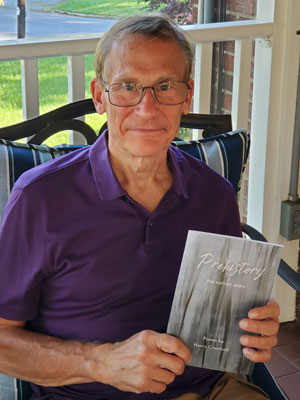|
Henry Crawford is a stand out poet
clearly positioned in the 21st Century.
On September 19, 2023,
the Steiny Road Poet
spoke with him about his
new chapbook Prehistory: the earliest years (printF Books, 2023) which, as he pointed out, is NOAI—"Nothing
contained herein was made
in whole or part by
artificial intelligence,
machine learning systems,
neural networks, or large
language models."
Crawford who is agile
with computers, the
Internet, and the
intelligence that is
pushing forth in our time
and who has innovated his
own brand of poetry with
such full-length books as American Software (CW Books, 2017) and Binary Planet (The Word Works, 2019) is boldly self-publishing. Prehistory follows his earlier chapbook The Little Box Theater (printF Books, 2022).

Why is Henry Crawford self-publishing when he has established a
record of publication in the small press market? He said because he
wants control over the layout (yes, he also knows how to use page
layout software). He says that he is uninterested in competing with
others and taking away some other poet's window of opportunity for
publication. Furthermore, he affirms that the freedom to make the
publication happen is exhilarating.
The collection is a meditation on vulnerability and the balance struck
between life and death. Here's how he describes coming into existence,
which at the same time grounds him as a poet philosopher. Steiny says
poet philosopher because life and light happen in the context of
extinction (death) as a cycle of being.
Beige
My final tenure as a blot of Precambrian
cells ended in nervous collapse.
Sweet flesh all around
falling and half-falling into new beige
bands. Light was at a premium.
It was an absolute house breaking
wreck. Rumbling and more
rumbling to come. Until everything
that had happened before
tumbled into extinction
only to happen again.
Crawford names himself Mr. Defiance. He said in the case of Prehistory, he wanted to create a non-rational, non-linear book that
went back in time to his first four years. The idea sprang from hearing
Grace Cavalieri conduct poetry workshops where she assigned her
students the task of getting in a metaphoric elevator to explore a floor
of that student's life. What did they see there? What happened on that
floor? Crawford was assisting Cavalieri with some technical aspect of
her workshop. He wasn't in the workshop, but the assignment took
hold.
What Crawford assigned himself was to write one-page poems that
featured one or two images and to keep things as simple as possible.
He wanted to emphasize experience and mine all the feelings of his
early existence which presented to him as an array of colors. He said,
"for example, red was usually angry and blue, the truth. The reality was
he was raised by an acholic mother who had many lovers and none of
these men ascended to the role of father. Crawford began the collection
with Red and a glimpse at who?— most likely his maternal grandfather
relegated to the basement and the coal bin to make possibly an
improvement there.
Red
In the basement
by the coal bin
my grandfather
put down his handsaw
with its curved red handle
and rusty teeth.
Shavings of curled pine
scattered on the floor.
Cut into the cinderblock wall
a window of webs
and coal dust
small as it was
provided all the light.
In this collection, men do not achieve respect or love even those blue
truthtellers like the aloof "meticulous detective" or the policemen who
put the boy to sleep after his mother had been beaten presumably by
one of her many boyfriends. Crawford states that the Blue poem on
page 17 is central to appreciating Prehistory and it marks when the
child grows up and develops hope. Through bowling, the mother lets
her children know that truth and strength are equivalent and will lead
to winning this game where the goal is to knock all the pins down.
A companion poem to that of page 17 is Steiny's favorite on page 27.
Pink
Her leaving is a bomb
detonated more like a land mine
sounding round the house.
Guernica in blood color
without the bulls
or horses.
Her wants unwound
in pink lipstick
matching
her bowling shirt
and scarf.
The fatherless night
adds an hour
for everything
to sink in
another to fall
asleep.
While the poem is titled "Pink," it has a reference to the color of blood
which of course is red. The departure of the mother signals danger to
the child who then has neither father nor mother protecting him as he
tries to sleep. Crawford's nightmare landscape is Pablo Picasso's
painting inspired by Germany's bombing of the Basque region of Spain
in 1937 during Spain's civil war and at the request of Francisco Franco.
It was a controversial action because it involved the killing of many
civilians. Crawford picks this complex image to suggest that he felt he
lived in a war zone where he did not know who his allies were.
Crawford calls Prehistory his Rosetta Stone for understanding all his
emotions that erupted at that time, such emotions as anger, loneliness,
and sexuality. This is a book that will appeal to adult readers at all
levels of experience with poetry.
|